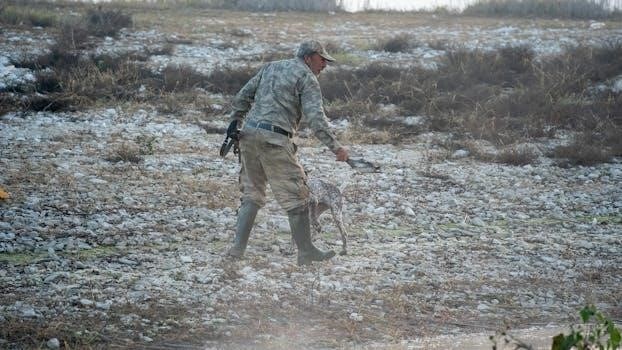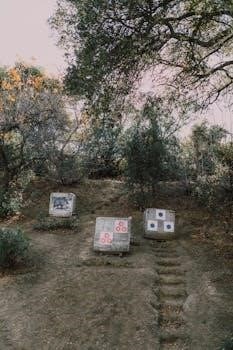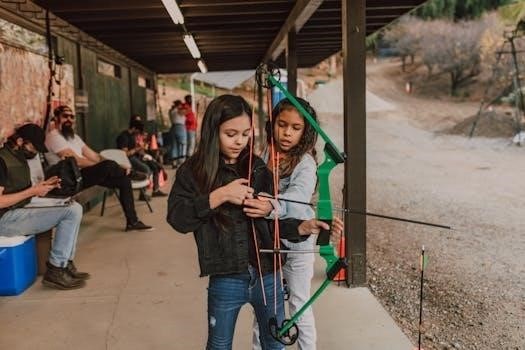What is a Hunting Guide?
A hunting guide plans and executes hunting trips for enthusiasts, finding legal hunting locations and securing necessary permissions․ They ensure a safe and successful hunting experience․ Some hunters may choose to contract with a guide for species other than those for which having a guide is mandatory․

Responsibilities of a Hunting Guide
The responsibilities of a hunting guide are multifaceted, demanding a blend of outdoor expertise and client management skills․ Primarily, the guide locates the best and legal hunting areas, securing necessary licenses and permissions․ They ensure the safety and ethical conduct of all hunts․
A hunting guide must be intimately familiar with the terrain, wildlife behavior, and applicable regulations․ Planning trips, including logistics for accessing remote areas and safely transporting game, is crucial․ Guides must also educate clients on hunting techniques, ethical practices, and local conservation efforts․
Effective communication is paramount, as guides must clearly convey instructions and ensure clients understand safety protocols․ They provide expertise on weapons, the area, and the wildlife to the clients․ They must be prepared to handle emergencies, provide first aid, and navigate challenging situations while maintaining a positive and professional demeanor․
Skills Required for a Hunting Guide
Becoming a successful hunting guide requires a diverse skillset, blending practical outdoor abilities with interpersonal expertise․ Essential skills include navigation and tracking in varied terrains, a deep understanding of wildlife behavior, and proficiency in handling firearms and other hunting equipment․ First aid and CPR certifications are mandatory for handling emergencies․
Strong communication skills are crucial for instructing clients, ensuring safety, and fostering a positive hunting experience․ A comprehensive knowledge of hunting regulations and ethical practices is essential for compliance and responsible hunting․ The ability to adapt to changing weather conditions and unexpected challenges is also vital․
Beyond technical skills, a hunting guide needs patience, problem-solving abilities, and a genuine passion for the outdoors․ They must be able to work effectively with diverse clients, manage expectations, and maintain a professional demeanor in demanding situations․ Knowledge of local flora and fauna adds to the experience․

Understanding the Time Commitment
A career as a hunting guide demands a significant time commitment, often exceeding traditional work hours․ The role involves extensive periods in the field, potentially lasting several days or weeks depending on the hunt and location․ This includes pre-hunt planning, scouting locations, and ensuring all necessary logistics are in place․
Guiding seasons are often concentrated around specific times of the year, aligning with hunting seasons for different species․ This can lead to periods of intense work followed by quieter periods․ During hunting season, guides may work long hours, often starting before dawn and continuing well into the evening, catering to client needs․
Beyond active hunts, guides dedicate time to equipment maintenance, administrative tasks, and ongoing professional development․ They must stay updated on changing regulations, refine their skills, and maintain necessary certifications․ Therefore, aspiring guides must realistically assess the time commitment and its impact on their personal lives․
Specialization by Region and Species
Hunting guides often specialize due to regional variations in species and conditions․ A guide familiar with one area may know little about another․ Specialization allows for expertise, increasing success and safety․
Alaska’s Unique Hunting Guide Requirements
Alaska presents unique challenges and regulations for hunting guides․ Due to great variations in species, hunting conditions, and weather patterns, guides often need specialized knowledge․ To become a hunting guide in Alaska, aspiring individuals must first work for a hunting outfitter for a minimum of two years․
This experience must include at least 60 days of on-the-job training as a packer, performing guide-related duties․ Furthermore, 30 of those days must be under the direct supervision of a licensed guide․ This rigorous training ensures familiarity with the specific demands of Alaskan hunts․
Non-residents hunting certain species in Alaska, such as brown/grizzly bear, black bear, bison, caribou, deer, elk, goat, moose, muskox, sheep, wolf, or wolverine, are often required to be accompanied by a licensed guide․
Licensing and Certification
To become a licensed hunting guide, you must possess a valid hunting license․ Many states require certifications in first aid, CPR, and hunter safety education․ A guide license applicant must also take a guide test and pass․
Hunter Education Course Requirement
Before aspiring hunting guides can even consider applying for a license or leading expeditions, they must typically complete a hunter education course․ This is a foundational requirement in most states, designed to ensure that all hunters, including future guides, possess a comprehensive understanding of safe hunting practices, ethical conduct, and wildlife conservation principles․
These courses cover a range of essential topics, including firearm safety, proper handling and storage of weapons, techniques for identifying different game species, and the importance of adhering to hunting regulations and laws․ The curriculum often includes hands-on training, simulations, and practical exercises to reinforce the theoretical knowledge․
Moreover, hunter education courses emphasize the ethical responsibilities of hunters, promoting fair chase principles, respect for wildlife and their habitats, and the avoidance of unnecessary harm or suffering․ By instilling these values, the courses aim to cultivate a culture of responsible hunting that prioritizes conservation and sustainability․ Passing a hunter education course is a prerequisite for obtaining a hunting license, which is a must-have for anyone seeking to become a hunting guide․
First Aid and CPR Certification
Beyond hunter education, possessing current certifications in First Aid and CPR (Cardiopulmonary Resuscitation) is often a mandatory requirement for aspiring hunting guides․ This reflects the inherent risks associated with outdoor adventures and the critical need for guides to be prepared to handle medical emergencies in remote locations․
First Aid certification equips guides with the knowledge and skills to address common injuries and illnesses that may occur during hunting trips, such as cuts, sprains, fractures, allergic reactions, and heatstroke․ They learn how to assess the severity of injuries, administer basic medical care, and stabilize patients until professional help arrives․
CPR certification trains guides in the life-saving techniques of chest compressions and rescue breathing, enabling them to respond effectively to cardiac arrest or other situations where a client’s breathing or heartbeat has stopped․ In remote wilderness areas, where immediate access to medical facilities is limited, the ability to perform CPR can be crucial in saving a life․

State-Specific Regulations
Every state has its own set of rules governing hunting guides․ Some states require licenses and memberships in certain associations․ Guides must know the laws and regulations of their state․
Alaska Hunting Guide Requirements
Becoming a hunting guide in Alaska involves specific steps․ To begin, you typically need to work for a registered hunting outfitter for at least two years․ This experience must include a minimum of 60 days of on-the-job training as a packer, performing duties related to guiding․ Crucially, 30 of those days must be spent under the direct supervision of a licensed Alaskan guide․
This hands-on experience provides invaluable knowledge of the Alaskan terrain, wildlife, and hunting regulations․ Furthermore, understand that Alaska has unique hunting conditions and weather patterns․ Great variations in species require guides to specialize; A guide familiar with one area may know little about another․ Nonresidents hunting certain species in Alaska are required to be accompanied by a guide․
Utah Hunting Guide License Application
To apply for a Hunting Guide license in Utah, several steps must be followed․ You’ll need to complete the official application form, providing all required information accurately․ A critical component of the application is the inclusion of three references who can vouch for your skills, experience, and character․
Notably, the Utah Division of Wildlife Resources requests that one of these references should come from a Guides Association or Hunters Association from the country where you have previously operated, if applicable․ This helps to verify your professional standing and experience in the field․ Ensure all documentation is complete and submitted according to the state’s guidelines to avoid delays in processing your application․ Meeting these requirements is essential for obtaining your license and practicing as a hunting guide in Utah․
Physical and Mental Demands
Becoming a hunting guide isn’t just about a love for the outdoors; it requires significant physical and mental resilience․ The physical demands can vary drastically depending on the type of hunt, ranging from relatively mild exertion during waterfowl or pheasant hunts to strenuous activity when pursuing big game like elk or moose in challenging terrains such as the Rockies or Alaska․
Guides often face long days, hiking with heavy gear, navigating difficult landscapes, and enduring adverse weather conditions․ Mentally, guides need to be sharp, making quick decisions in potentially dangerous situations, managing clients’ expectations and safety, and remaining calm under pressure․ The ability to plan, adapt, and problem-solve in remote environments is crucial for ensuring a successful and safe hunting experience for everyone involved․

Financial Aspects of Being a Hunting Guide
Pursuing a career as a hunting guide involves careful consideration of the financial realities․ While the profession can be rewarding for those passionate about hunting, it’s generally not considered a path to riches․ Income can vary significantly depending on factors such as location, species hunted, experience level, and whether the guide works for an outfitter or independently․
Guides often face seasonal work, meaning income may be concentrated during hunting seasons․ Expenses can include equipment, transportation, licensing, insurance, and marketing․ Building a client base takes time and effort․ It’s essential to have a solid business plan and manage finances wisely․ While some guides may earn a comfortable living, it’s crucial to have realistic expectations and be prepared for the financial challenges of this profession․ Diversification of income streams, such as offering other outdoor activities or services, can also be beneficial․
Working for an Outfitter vs․ Independent Guiding
Aspiring hunting guides face a crucial decision⁚ working for an established outfitter or venturing into independent guiding․ Each path offers distinct advantages and disadvantages․ Outfitters provide a structured environment, often handling marketing, logistics, and client acquisition․ This can be ideal for new guides seeking experience and a steady income stream․ However, outfitters typically take a percentage of the guide’s earnings․
Independent guiding offers greater autonomy and the potential for higher profits․ Guides can set their rates, choose their clients, and tailor their services․ However, independent guides are responsible for all aspects of the business, including marketing, insurance, and securing permits․ This route requires strong business acumen and a proactive approach to attracting clients․ Ultimately, the best choice depends on the guide’s experience, financial resources, and entrepreneurial spirit․
Importance of Contracts
Contracts are paramount in the hunting guide industry, serving as a crucial safeguard for both guides and clients․ A well-drafted contract clearly outlines the services provided, payment terms, cancellation policies, and liability waivers․ It minimizes misunderstandings and disputes, fostering a professional and transparent relationship․
For guides, contracts ensure they receive fair compensation for their expertise and time․ They also protect against potential legal issues arising from accidents or unforeseen circumstances․ For clients, contracts provide clarity on the scope of the hunt, the guide’s responsibilities, and the expected level of service․ They offer recourse in case of breach of contract or negligence on the guide’s part․ Furthermore, many hunts require a signed guide-client contract․ In essence, contracts establish clear expectations and provide a framework for a successful and mutually beneficial hunting experience․
